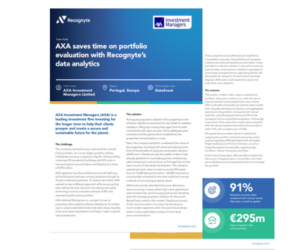13 Feb 2023
The company wanted to buy a sub portfolio named Forte portfolio, of a much larger portfolio sold by Fidelidade insurance company to Apollo. Forte portfolio comprised 55 residential buildings with 870 units in various locations around Lisbon and Setubal at a value of €295 million.
AXA agreed to buy the portfolio but was still defining its final bid price and was running valuations through its chosen underwriting partner. To reduce risk further, AXA wanted to test a different approach while ensuring they were taking the best decisions by testing real estate technology tools to evaluate a sample of 80 units representing the entire portfolio.
AXA selected Recognyte on a project to use its proprietary data analytics software, DataScout. Its mission was to acquire estimated rental and sales values, liquidity times and capex assumptions and help it make a capital value assessment.
Recognyte prepared a dataset of the properties in the software. DataScout extracted ten key labels for address validation, filling any missing data gaps from its wide connectivity with open sources. Once addresses were complete and the geolocations established, the properties were plotted on a map.
Next, the company wanted to understand the value of the properties, knowing both rental and asking prices. One of the benefits of using the automated valuation (AVM) tool in DataScout was the wealth of data it had already gathered on local asking prices, rental prices, sales transactions, and auctions, as Portugal has no free open source of real estate transactions. The valuation assessment took a few minutes to review 870 assets from its 15,000 data points (rents + 60,000 transactions countrywide) compared to the slow traditional manual methods of uncovering property values.
AXA had correctly identified that price distortions were occurring in areas where high-value apartments were located near social housing and would, therefore, skew the average property valuation for the parish. Being finely tuned to the market, DataScout proved to be more accurate in its output by focusing on much smaller segments within the parish boundaries, where it discovered distinct areas of micro-level price concentrations.
AXA wanted to know how to handle each property to maximise yield and find where there was trapped value and what capital-expenditure would be needed to improve yields. The software assessed each property’s target market using the audiences feature, gathering the number and type of points of interest (POIs) surrounding the property. It would automatically suggest whether the property was more suited to short term rentals targeted towards students or else, working professionals and families looking for a more permanent home.
Another aim of the sampling was to determine how many properties might fall below standard and need some capital expenditure. Here, its image recognition technology assessed images of property interiors and exteriors. From these images, it determined a range of property characteristics, including an age assessment, property type and gave it a good or poor condition rating. An overview of the results was shared with the client, demonstrating how powerful the software could be in helping them to understand the capital expenditure required for refurbishment.
With most properties in the sample having a lease, AXA needed to assess properties for Net Present Value (NPV). Therefore, valuations had to account for future rent collections on occupied properties to help them decide the best monetisation strategy. By comparing both sales and rent scenarios with capex assumptions, this would indicate whether a property was worth investing in.
Some older leases had their tenants protected by law (prior to N RAU), where there would be long notice periods to update market rents or where you could not break the lease. These properties would effectively be classified as impossible to renovate. Using DataScout’s property locations and sold and rental price information, these provided an indication whether it was worth continuing with the lease, rental period or whether it was better to review lease arrangements by negotiating directly with the tenants for renewal or for termination and asset disposal. AXA’s team could assess the output and make their own judgments.
The analytic models made it easy to evaluate the portfolio, taking just a week to run, while the team’s manual valuation of the sample took over a month. AXA could easily and quickly see asset-by-asset insights with a liquidity estimate and valuation, and aggregated statistics for the portfolio. Compared with manual methods, using Recognyte had saved 75% of the company’s time on its portfolio evaluation. A thorough cross check of the automation results were compared with the manual results and proved to be accurate to within 91%, with a median error of €100.
Recognyte also provided a dynamic dashboard, mapping the portfolio and summarizing key metric outputs regarding AVM (estimated rents and sales), Target Audiences and Points of Interest, as well as Image Recognition functionality, assessing Age, Condition, Interior Occupancy and Type.
At the end of the project, AXA was able to determine the source of trapped value in its portfolio and make sound decisions once it acquired and went on to manage this portfolio.
